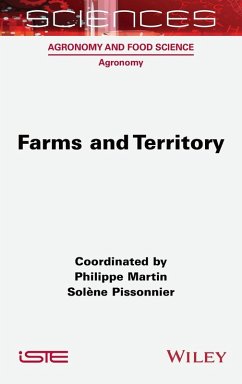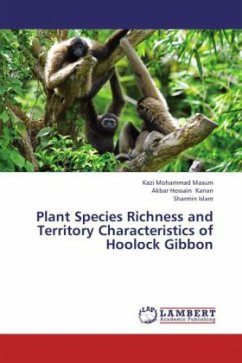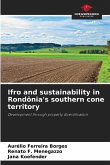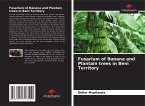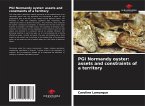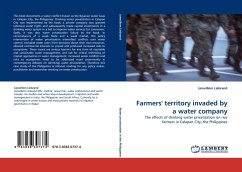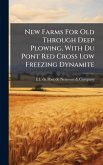Farms and Territory
Herausgeber: Martin, Philippe; Pissonnier, Solène
Farms and Territory
Herausgeber: Martin, Philippe; Pissonnier, Solène
- Gebundenes Buch
- Merkliste
- Auf die Merkliste
- Bewerten Bewerten
- Teilen
- Produkt teilen
- Produkterinnerung
- Produkterinnerung
What are the new relationships between territories and farms? Farms and Territory addresses this question by exploring a range of landscapes, from mountains to cereal plains, forged by different actors who exploit and protect resources such as land and wild - or domestic - biodiversity. These territories are also the site of renewed interactions between farms for the use of biomass, whether for methanization or herd feeding. This book focuses on the various methods and tools used to diagnose, design or evaluate agricultural dynamics in territories: database matching, material and energy flow…mehr
Andere Kunden interessierten sich auch für
![The Stanislaus and Lake Tahoe Forest Reserves and Adjacent Territory The Stanislaus and Lake Tahoe Forest Reserves and Adjacent Territory]() George Bishop SudworthThe Stanislaus and Lake Tahoe Forest Reserves and Adjacent Territory32,99 €
George Bishop SudworthThe Stanislaus and Lake Tahoe Forest Reserves and Adjacent Territory32,99 €![Plant Species Richness and Territory Characteristics of Hoolock Gibbon Plant Species Richness and Territory Characteristics of Hoolock Gibbon]() Kazi Mohammad MasumPlant Species Richness and Territory Characteristics of Hoolock Gibbon24,99 €
Kazi Mohammad MasumPlant Species Richness and Territory Characteristics of Hoolock Gibbon24,99 €![Ifro and sustainability in Rondônia's southern cone territory Ifro and sustainability in Rondônia's southern cone territory]() Aurélio Ferreira BorgesIfro and sustainability in Rondônia's southern cone territory30,99 €
Aurélio Ferreira BorgesIfro and sustainability in Rondônia's southern cone territory30,99 €![Fusarium of Banana and Plantain trees in Beni Territory Fusarium of Banana and Plantain trees in Beni Territory]() Didier MupitanjiaFusarium of Banana and Plantain trees in Beni Territory27,99 €
Didier MupitanjiaFusarium of Banana and Plantain trees in Beni Territory27,99 €![PGI Normandy oyster: assets and constraints of a territory PGI Normandy oyster: assets and constraints of a territory]() Caroline LamarquePGI Normandy oyster: assets and constraints of a territory27,99 €
Caroline LamarquePGI Normandy oyster: assets and constraints of a territory27,99 €![Farmers'' territory invaded by a water company Farmers'' territory invaded by a water company]() Janwillem LiebrandFarmers'' territory invaded by a water company52,99 €
Janwillem LiebrandFarmers'' territory invaded by a water company52,99 €![New Farms For Old Through Deep Plowing, With Du Pont Red Cross Low Freezing Dynamite New Farms For Old Through Deep Plowing, With Du Pont Red Cross Low Freezing Dynamite]() New Farms For Old Through Deep Plowing, With Du Pont Red Cross Low Freezing Dynamite25,99 €
New Farms For Old Through Deep Plowing, With Du Pont Red Cross Low Freezing Dynamite25,99 €-
-
-
What are the new relationships between territories and farms? Farms and Territory addresses this question by exploring a range of landscapes, from mountains to cereal plains, forged by different actors who exploit and protect resources such as land and wild - or domestic - biodiversity. These territories are also the site of renewed interactions between farms for the use of biomass, whether for methanization or herd feeding. This book focuses on the various methods and tools used to diagnose, design or evaluate agricultural dynamics in territories: database matching, material and energy flow calculations, codesign approaches, etc. In short, this book illustrates the diversity of work carried out at the farm-territory interface by research teams to understand changes in the agricultural world and the ecological, economic and societal impacts.
Produktdetails
- Produktdetails
- Verlag: Wiley
- Seitenzahl: 336
- Erscheinungstermin: 30. September 2025
- Englisch
- Abmessung: 234mm x 156mm x 19mm
- Gewicht: 635g
- ISBN-13: 9781789452266
- ISBN-10: 1789452260
- Artikelnr.: 75166539
- Herstellerkennzeichnung
- Libri GmbH
- Europaallee 1
- 36244 Bad Hersfeld
- gpsr@libri.de
- Verlag: Wiley
- Seitenzahl: 336
- Erscheinungstermin: 30. September 2025
- Englisch
- Abmessung: 234mm x 156mm x 19mm
- Gewicht: 635g
- ISBN-13: 9781789452266
- ISBN-10: 1789452260
- Artikelnr.: 75166539
- Herstellerkennzeichnung
- Libri GmbH
- Europaallee 1
- 36244 Bad Hersfeld
- gpsr@libri.de
Philippe Martin works as a professor at AgroParisTech, France. His research, conducted at the SADAPT Joint Research Unit (UMR SADAPT), focuses on the dynamics of agricultural systems within territories, using mixed approaches (database analysis and field surveys). Solène Pissonnier works as Associate Professor at AgroParisTech and the SADAPT Joint Research Unit (UMR SADAPT), France. Her work focuses on crop-livestock interactions at the territorial level, particularly on developing methodologies to support their development.
Introduction xiii
Philippe MARTIN and Solène PISSONNIER
Chapter 1. Which Land Resources to Adopt for an Ecological Transition of
Agri-Food Systems? A Cross-View of Law and Sociology 1
Pierre-Etienne BOUILLOT and Romain MELOT
1.1. Legal framework and contractual practices in farming: towards a
greening of land tools? 2
1.2. Changes in agricultural landholding structures: a challenge for the
transition of agri-food systems and generational renewal 9
1.3. The multifunctionality of agricultural land in food systems 13
1.4. Conclusion and perspectives 15
1.5. References 16
Chapter 2. Synergies between Animal Husbandry and Forests for the
Development of Agroecological Systems in Middle Mountain and Mediterranean
Foothill Regions: Comparative Study of the Limousine Mountain and the
Lodevois 23
Nathan MORSEL and Nadège GARAMBOIS
2.1. Introduction 23
2.2. The Lodevois and the Limousine Mountain: a disconnection between
animal husbandry and forestry 27
2.3. Frugal agropastoral systems: putting grazing back at the heart of herd
feeding, especially in forest ecosystems 33
2.4. Obstacles to the use of wooded areas on the Limousine Mountain and the
Lodevois: an overview 39
2.5. Ways to promote the (re)connection between livestock and forests 43
2.6. Conclusion 46
2.7. References 47
Chapter 3. Crop-Livestock Interaction at the Territorial Scale: Tools and
Methods to Support Its Development 51
Solène PISSONNIER
3.1. Introduction 51
3.2. Specialization and its ramifications 52
3.3. Characteristics of systems integrating crops and livestock 56
3.4. Spatial and temporal coordinations on a territorial scale 59
3.5. Types of actors involved and forms of partnership 61
3.6. Methods for diagnosing, designing, evaluating and supporting the
development of these systems 67
3.7. Conclusion 75
3.8. References 75
Chapter 4. Genetic Choices, Farming Systems and Territories 81
Etienne VERRIER and Anne LAUVIE
4.1. Introduction 81
4.2. Organization of animal breeding and the role of farmers, farming
systems and links to the territory 82
4.3. Collective breeding goals and territories 85
4.4. Breeds, farmers' collectives and other territorial components:
diversity of relationships 88
4.5. Individual farmers' decisions and how they relate to breeding
collectives' decisions 91
4.6. Conclusion 93
4.7. References 94
Chapter 5. Town Microfarms, Country Microfarms in Fields: Innovative
Systems in Contrasting Territories 97
Agnès LELIÈVRE and Kevin MOREL
5.1. Innovative projects in response to a variety of socio-ecological
territorial challenges 97
5.2. Multiple innovations driven by new farmer profiles 100
5.3. Discussion and perspectives 110
5.4. References 112
Chapter 6. The Rise of Professional Gathering in Rural Areas 115
Valentin ASSELAIN and Florence PINTON
6.1. Introduction 115
6.2. A centuries-old business embedded in agroecosystems 118
6.3. Make a living by gathering 125
6.4. Gathering territories and rural areas: separate paths or mutual
learning? 133
6.5. Conclusion 139
6.6. References 140
Chapter 7. How Can Biodiversity Be Taken into Account on Farm Territories?
145
Aude BARBOTTIN, Daphnée DURANT, Raymond REAU and Hélène GROSS
7.1. What is biodiversity in agricultural landscapes? 145
7.2. Biodiversity as seen by farmers 146
7.3. Can agriculture and biodiversity conciliation occur at the farm
territory level? 148
7.4. How can we support biodiversity conservation at farm level? 150
7.5. Examples of integrating biodiversity into farm projects: challenges,
results and difficulties 157
7.6. Monitoring biodiversity 164
7.7. Conclusion 165
7.8. References 166
Chapter 8. Sociometabolic Approaches to Conceptualizing and Supporting
Agri-Food Transitions 171
Caroline PETIT and Thierry BONAUDO
8.1. Introduction 171
8.2. Society's metabolism: overview of epistemological foundations and
current research trends 173
8.3. Agriculture in the metabolism of societies 176
8.4. For agri-food metabolism approaches at the local scale 179
8.5. Discussion: avenues for further exploration and prospects for
cross-disciplinary work between sociometabolic approaches and agronomy 184
8.6. Conclusion 188
8.7. References 188
Chapter 9. Farms in the Transition to Sustainable Food in Urban Areas: The
Role of Collective Catering 195
Christine AUBRY and Emmanuel RAYNAUD
9.1. Introduction 195
9.2. Collective catering: a vector for sustainable food practices 196
9.3. Adapting agricultural production to meet growing demand for
sustainable food: the example of Île-de-France 205
9.4. Conclusion 211
9.5. References 212
Chapter 10. Farming and the Circular Economy in Territories: Recycling
Urban Waste in Agriculture 217
Florent LEVAVASSEUR and Sabine HOUOT
10.1. Introduction 217
10.2. From urban waste to organic fertilizer 219
10.3. Regulations governing the return of urban OWPs to the soil in
agriculture 227
10.4. How to meet the needs of agriculture 229
10.5. What are the challenges associated with the agricultural recycling of
municipal waste? 234
10.6. Environmental balance sheet 238
10.7. Value chain organization 240
10.8. Farmers' perception of agricultural recycling of urban OWPs and
social acceptability. 240
10.9. Conclusion 241
10.10. Reference 242
Chapter 11. Biogas and Biomass Valorization Circuits at the Farm and
Territory Levels 249
Jeanne CADIOU and Jean-Marc MEYNARD
11.1. Introduction 249
11.2. New biomass flows find new uses in agriculture 251
11.3. By modifying the flows and uses of biomass, biogas production renews
the links between farms and territory: a case
study from Grand Est 254
11.4. New sustainability challenges emerge on farms and in territories 259
11.5. A biogas development policy faced with the challenge of current
regulatory dynamics? 263
11.6. Conclusion 265
11.7. Reference 265
Chapter 12. Databases for Analyzing Relationships Between Farm Holdings and
Territories 269
Philippe MARTIN and Myriam GRILLOT
12.1. Interest in and availability of databases for the analysis of
farm-territory relationships 269
12.2. Databases 271
12.3. SI-BOAT: an information system for agri-food systems 282
12.4. Enhancing the impact of RPG: the RPG Explorer project 289
12.5. Conclusion 300
12.6. References 301
12.7. Webography for further information or access to the databases cited
303
Conclusion 305
Philippe MARTIN and Solène PISSONNIER
List of Authors 307
Index 311
Philippe MARTIN and Solène PISSONNIER
Chapter 1. Which Land Resources to Adopt for an Ecological Transition of
Agri-Food Systems? A Cross-View of Law and Sociology 1
Pierre-Etienne BOUILLOT and Romain MELOT
1.1. Legal framework and contractual practices in farming: towards a
greening of land tools? 2
1.2. Changes in agricultural landholding structures: a challenge for the
transition of agri-food systems and generational renewal 9
1.3. The multifunctionality of agricultural land in food systems 13
1.4. Conclusion and perspectives 15
1.5. References 16
Chapter 2. Synergies between Animal Husbandry and Forests for the
Development of Agroecological Systems in Middle Mountain and Mediterranean
Foothill Regions: Comparative Study of the Limousine Mountain and the
Lodevois 23
Nathan MORSEL and Nadège GARAMBOIS
2.1. Introduction 23
2.2. The Lodevois and the Limousine Mountain: a disconnection between
animal husbandry and forestry 27
2.3. Frugal agropastoral systems: putting grazing back at the heart of herd
feeding, especially in forest ecosystems 33
2.4. Obstacles to the use of wooded areas on the Limousine Mountain and the
Lodevois: an overview 39
2.5. Ways to promote the (re)connection between livestock and forests 43
2.6. Conclusion 46
2.7. References 47
Chapter 3. Crop-Livestock Interaction at the Territorial Scale: Tools and
Methods to Support Its Development 51
Solène PISSONNIER
3.1. Introduction 51
3.2. Specialization and its ramifications 52
3.3. Characteristics of systems integrating crops and livestock 56
3.4. Spatial and temporal coordinations on a territorial scale 59
3.5. Types of actors involved and forms of partnership 61
3.6. Methods for diagnosing, designing, evaluating and supporting the
development of these systems 67
3.7. Conclusion 75
3.8. References 75
Chapter 4. Genetic Choices, Farming Systems and Territories 81
Etienne VERRIER and Anne LAUVIE
4.1. Introduction 81
4.2. Organization of animal breeding and the role of farmers, farming
systems and links to the territory 82
4.3. Collective breeding goals and territories 85
4.4. Breeds, farmers' collectives and other territorial components:
diversity of relationships 88
4.5. Individual farmers' decisions and how they relate to breeding
collectives' decisions 91
4.6. Conclusion 93
4.7. References 94
Chapter 5. Town Microfarms, Country Microfarms in Fields: Innovative
Systems in Contrasting Territories 97
Agnès LELIÈVRE and Kevin MOREL
5.1. Innovative projects in response to a variety of socio-ecological
territorial challenges 97
5.2. Multiple innovations driven by new farmer profiles 100
5.3. Discussion and perspectives 110
5.4. References 112
Chapter 6. The Rise of Professional Gathering in Rural Areas 115
Valentin ASSELAIN and Florence PINTON
6.1. Introduction 115
6.2. A centuries-old business embedded in agroecosystems 118
6.3. Make a living by gathering 125
6.4. Gathering territories and rural areas: separate paths or mutual
learning? 133
6.5. Conclusion 139
6.6. References 140
Chapter 7. How Can Biodiversity Be Taken into Account on Farm Territories?
145
Aude BARBOTTIN, Daphnée DURANT, Raymond REAU and Hélène GROSS
7.1. What is biodiversity in agricultural landscapes? 145
7.2. Biodiversity as seen by farmers 146
7.3. Can agriculture and biodiversity conciliation occur at the farm
territory level? 148
7.4. How can we support biodiversity conservation at farm level? 150
7.5. Examples of integrating biodiversity into farm projects: challenges,
results and difficulties 157
7.6. Monitoring biodiversity 164
7.7. Conclusion 165
7.8. References 166
Chapter 8. Sociometabolic Approaches to Conceptualizing and Supporting
Agri-Food Transitions 171
Caroline PETIT and Thierry BONAUDO
8.1. Introduction 171
8.2. Society's metabolism: overview of epistemological foundations and
current research trends 173
8.3. Agriculture in the metabolism of societies 176
8.4. For agri-food metabolism approaches at the local scale 179
8.5. Discussion: avenues for further exploration and prospects for
cross-disciplinary work between sociometabolic approaches and agronomy 184
8.6. Conclusion 188
8.7. References 188
Chapter 9. Farms in the Transition to Sustainable Food in Urban Areas: The
Role of Collective Catering 195
Christine AUBRY and Emmanuel RAYNAUD
9.1. Introduction 195
9.2. Collective catering: a vector for sustainable food practices 196
9.3. Adapting agricultural production to meet growing demand for
sustainable food: the example of Île-de-France 205
9.4. Conclusion 211
9.5. References 212
Chapter 10. Farming and the Circular Economy in Territories: Recycling
Urban Waste in Agriculture 217
Florent LEVAVASSEUR and Sabine HOUOT
10.1. Introduction 217
10.2. From urban waste to organic fertilizer 219
10.3. Regulations governing the return of urban OWPs to the soil in
agriculture 227
10.4. How to meet the needs of agriculture 229
10.5. What are the challenges associated with the agricultural recycling of
municipal waste? 234
10.6. Environmental balance sheet 238
10.7. Value chain organization 240
10.8. Farmers' perception of agricultural recycling of urban OWPs and
social acceptability. 240
10.9. Conclusion 241
10.10. Reference 242
Chapter 11. Biogas and Biomass Valorization Circuits at the Farm and
Territory Levels 249
Jeanne CADIOU and Jean-Marc MEYNARD
11.1. Introduction 249
11.2. New biomass flows find new uses in agriculture 251
11.3. By modifying the flows and uses of biomass, biogas production renews
the links between farms and territory: a case
study from Grand Est 254
11.4. New sustainability challenges emerge on farms and in territories 259
11.5. A biogas development policy faced with the challenge of current
regulatory dynamics? 263
11.6. Conclusion 265
11.7. Reference 265
Chapter 12. Databases for Analyzing Relationships Between Farm Holdings and
Territories 269
Philippe MARTIN and Myriam GRILLOT
12.1. Interest in and availability of databases for the analysis of
farm-territory relationships 269
12.2. Databases 271
12.3. SI-BOAT: an information system for agri-food systems 282
12.4. Enhancing the impact of RPG: the RPG Explorer project 289
12.5. Conclusion 300
12.6. References 301
12.7. Webography for further information or access to the databases cited
303
Conclusion 305
Philippe MARTIN and Solène PISSONNIER
List of Authors 307
Index 311
Introduction xiii
Philippe MARTIN and Solène PISSONNIER
Chapter 1. Which Land Resources to Adopt for an Ecological Transition of
Agri-Food Systems? A Cross-View of Law and Sociology 1
Pierre-Etienne BOUILLOT and Romain MELOT
1.1. Legal framework and contractual practices in farming: towards a
greening of land tools? 2
1.2. Changes in agricultural landholding structures: a challenge for the
transition of agri-food systems and generational renewal 9
1.3. The multifunctionality of agricultural land in food systems 13
1.4. Conclusion and perspectives 15
1.5. References 16
Chapter 2. Synergies between Animal Husbandry and Forests for the
Development of Agroecological Systems in Middle Mountain and Mediterranean
Foothill Regions: Comparative Study of the Limousine Mountain and the
Lodevois 23
Nathan MORSEL and Nadège GARAMBOIS
2.1. Introduction 23
2.2. The Lodevois and the Limousine Mountain: a disconnection between
animal husbandry and forestry 27
2.3. Frugal agropastoral systems: putting grazing back at the heart of herd
feeding, especially in forest ecosystems 33
2.4. Obstacles to the use of wooded areas on the Limousine Mountain and the
Lodevois: an overview 39
2.5. Ways to promote the (re)connection between livestock and forests 43
2.6. Conclusion 46
2.7. References 47
Chapter 3. Crop-Livestock Interaction at the Territorial Scale: Tools and
Methods to Support Its Development 51
Solène PISSONNIER
3.1. Introduction 51
3.2. Specialization and its ramifications 52
3.3. Characteristics of systems integrating crops and livestock 56
3.4. Spatial and temporal coordinations on a territorial scale 59
3.5. Types of actors involved and forms of partnership 61
3.6. Methods for diagnosing, designing, evaluating and supporting the
development of these systems 67
3.7. Conclusion 75
3.8. References 75
Chapter 4. Genetic Choices, Farming Systems and Territories 81
Etienne VERRIER and Anne LAUVIE
4.1. Introduction 81
4.2. Organization of animal breeding and the role of farmers, farming
systems and links to the territory 82
4.3. Collective breeding goals and territories 85
4.4. Breeds, farmers' collectives and other territorial components:
diversity of relationships 88
4.5. Individual farmers' decisions and how they relate to breeding
collectives' decisions 91
4.6. Conclusion 93
4.7. References 94
Chapter 5. Town Microfarms, Country Microfarms in Fields: Innovative
Systems in Contrasting Territories 97
Agnès LELIÈVRE and Kevin MOREL
5.1. Innovative projects in response to a variety of socio-ecological
territorial challenges 97
5.2. Multiple innovations driven by new farmer profiles 100
5.3. Discussion and perspectives 110
5.4. References 112
Chapter 6. The Rise of Professional Gathering in Rural Areas 115
Valentin ASSELAIN and Florence PINTON
6.1. Introduction 115
6.2. A centuries-old business embedded in agroecosystems 118
6.3. Make a living by gathering 125
6.4. Gathering territories and rural areas: separate paths or mutual
learning? 133
6.5. Conclusion 139
6.6. References 140
Chapter 7. How Can Biodiversity Be Taken into Account on Farm Territories?
145
Aude BARBOTTIN, Daphnée DURANT, Raymond REAU and Hélène GROSS
7.1. What is biodiversity in agricultural landscapes? 145
7.2. Biodiversity as seen by farmers 146
7.3. Can agriculture and biodiversity conciliation occur at the farm
territory level? 148
7.4. How can we support biodiversity conservation at farm level? 150
7.5. Examples of integrating biodiversity into farm projects: challenges,
results and difficulties 157
7.6. Monitoring biodiversity 164
7.7. Conclusion 165
7.8. References 166
Chapter 8. Sociometabolic Approaches to Conceptualizing and Supporting
Agri-Food Transitions 171
Caroline PETIT and Thierry BONAUDO
8.1. Introduction 171
8.2. Society's metabolism: overview of epistemological foundations and
current research trends 173
8.3. Agriculture in the metabolism of societies 176
8.4. For agri-food metabolism approaches at the local scale 179
8.5. Discussion: avenues for further exploration and prospects for
cross-disciplinary work between sociometabolic approaches and agronomy 184
8.6. Conclusion 188
8.7. References 188
Chapter 9. Farms in the Transition to Sustainable Food in Urban Areas: The
Role of Collective Catering 195
Christine AUBRY and Emmanuel RAYNAUD
9.1. Introduction 195
9.2. Collective catering: a vector for sustainable food practices 196
9.3. Adapting agricultural production to meet growing demand for
sustainable food: the example of Île-de-France 205
9.4. Conclusion 211
9.5. References 212
Chapter 10. Farming and the Circular Economy in Territories: Recycling
Urban Waste in Agriculture 217
Florent LEVAVASSEUR and Sabine HOUOT
10.1. Introduction 217
10.2. From urban waste to organic fertilizer 219
10.3. Regulations governing the return of urban OWPs to the soil in
agriculture 227
10.4. How to meet the needs of agriculture 229
10.5. What are the challenges associated with the agricultural recycling of
municipal waste? 234
10.6. Environmental balance sheet 238
10.7. Value chain organization 240
10.8. Farmers' perception of agricultural recycling of urban OWPs and
social acceptability. 240
10.9. Conclusion 241
10.10. Reference 242
Chapter 11. Biogas and Biomass Valorization Circuits at the Farm and
Territory Levels 249
Jeanne CADIOU and Jean-Marc MEYNARD
11.1. Introduction 249
11.2. New biomass flows find new uses in agriculture 251
11.3. By modifying the flows and uses of biomass, biogas production renews
the links between farms and territory: a case
study from Grand Est 254
11.4. New sustainability challenges emerge on farms and in territories 259
11.5. A biogas development policy faced with the challenge of current
regulatory dynamics? 263
11.6. Conclusion 265
11.7. Reference 265
Chapter 12. Databases for Analyzing Relationships Between Farm Holdings and
Territories 269
Philippe MARTIN and Myriam GRILLOT
12.1. Interest in and availability of databases for the analysis of
farm-territory relationships 269
12.2. Databases 271
12.3. SI-BOAT: an information system for agri-food systems 282
12.4. Enhancing the impact of RPG: the RPG Explorer project 289
12.5. Conclusion 300
12.6. References 301
12.7. Webography for further information or access to the databases cited
303
Conclusion 305
Philippe MARTIN and Solène PISSONNIER
List of Authors 307
Index 311
Philippe MARTIN and Solène PISSONNIER
Chapter 1. Which Land Resources to Adopt for an Ecological Transition of
Agri-Food Systems? A Cross-View of Law and Sociology 1
Pierre-Etienne BOUILLOT and Romain MELOT
1.1. Legal framework and contractual practices in farming: towards a
greening of land tools? 2
1.2. Changes in agricultural landholding structures: a challenge for the
transition of agri-food systems and generational renewal 9
1.3. The multifunctionality of agricultural land in food systems 13
1.4. Conclusion and perspectives 15
1.5. References 16
Chapter 2. Synergies between Animal Husbandry and Forests for the
Development of Agroecological Systems in Middle Mountain and Mediterranean
Foothill Regions: Comparative Study of the Limousine Mountain and the
Lodevois 23
Nathan MORSEL and Nadège GARAMBOIS
2.1. Introduction 23
2.2. The Lodevois and the Limousine Mountain: a disconnection between
animal husbandry and forestry 27
2.3. Frugal agropastoral systems: putting grazing back at the heart of herd
feeding, especially in forest ecosystems 33
2.4. Obstacles to the use of wooded areas on the Limousine Mountain and the
Lodevois: an overview 39
2.5. Ways to promote the (re)connection between livestock and forests 43
2.6. Conclusion 46
2.7. References 47
Chapter 3. Crop-Livestock Interaction at the Territorial Scale: Tools and
Methods to Support Its Development 51
Solène PISSONNIER
3.1. Introduction 51
3.2. Specialization and its ramifications 52
3.3. Characteristics of systems integrating crops and livestock 56
3.4. Spatial and temporal coordinations on a territorial scale 59
3.5. Types of actors involved and forms of partnership 61
3.6. Methods for diagnosing, designing, evaluating and supporting the
development of these systems 67
3.7. Conclusion 75
3.8. References 75
Chapter 4. Genetic Choices, Farming Systems and Territories 81
Etienne VERRIER and Anne LAUVIE
4.1. Introduction 81
4.2. Organization of animal breeding and the role of farmers, farming
systems and links to the territory 82
4.3. Collective breeding goals and territories 85
4.4. Breeds, farmers' collectives and other territorial components:
diversity of relationships 88
4.5. Individual farmers' decisions and how they relate to breeding
collectives' decisions 91
4.6. Conclusion 93
4.7. References 94
Chapter 5. Town Microfarms, Country Microfarms in Fields: Innovative
Systems in Contrasting Territories 97
Agnès LELIÈVRE and Kevin MOREL
5.1. Innovative projects in response to a variety of socio-ecological
territorial challenges 97
5.2. Multiple innovations driven by new farmer profiles 100
5.3. Discussion and perspectives 110
5.4. References 112
Chapter 6. The Rise of Professional Gathering in Rural Areas 115
Valentin ASSELAIN and Florence PINTON
6.1. Introduction 115
6.2. A centuries-old business embedded in agroecosystems 118
6.3. Make a living by gathering 125
6.4. Gathering territories and rural areas: separate paths or mutual
learning? 133
6.5. Conclusion 139
6.6. References 140
Chapter 7. How Can Biodiversity Be Taken into Account on Farm Territories?
145
Aude BARBOTTIN, Daphnée DURANT, Raymond REAU and Hélène GROSS
7.1. What is biodiversity in agricultural landscapes? 145
7.2. Biodiversity as seen by farmers 146
7.3. Can agriculture and biodiversity conciliation occur at the farm
territory level? 148
7.4. How can we support biodiversity conservation at farm level? 150
7.5. Examples of integrating biodiversity into farm projects: challenges,
results and difficulties 157
7.6. Monitoring biodiversity 164
7.7. Conclusion 165
7.8. References 166
Chapter 8. Sociometabolic Approaches to Conceptualizing and Supporting
Agri-Food Transitions 171
Caroline PETIT and Thierry BONAUDO
8.1. Introduction 171
8.2. Society's metabolism: overview of epistemological foundations and
current research trends 173
8.3. Agriculture in the metabolism of societies 176
8.4. For agri-food metabolism approaches at the local scale 179
8.5. Discussion: avenues for further exploration and prospects for
cross-disciplinary work between sociometabolic approaches and agronomy 184
8.6. Conclusion 188
8.7. References 188
Chapter 9. Farms in the Transition to Sustainable Food in Urban Areas: The
Role of Collective Catering 195
Christine AUBRY and Emmanuel RAYNAUD
9.1. Introduction 195
9.2. Collective catering: a vector for sustainable food practices 196
9.3. Adapting agricultural production to meet growing demand for
sustainable food: the example of Île-de-France 205
9.4. Conclusion 211
9.5. References 212
Chapter 10. Farming and the Circular Economy in Territories: Recycling
Urban Waste in Agriculture 217
Florent LEVAVASSEUR and Sabine HOUOT
10.1. Introduction 217
10.2. From urban waste to organic fertilizer 219
10.3. Regulations governing the return of urban OWPs to the soil in
agriculture 227
10.4. How to meet the needs of agriculture 229
10.5. What are the challenges associated with the agricultural recycling of
municipal waste? 234
10.6. Environmental balance sheet 238
10.7. Value chain organization 240
10.8. Farmers' perception of agricultural recycling of urban OWPs and
social acceptability. 240
10.9. Conclusion 241
10.10. Reference 242
Chapter 11. Biogas and Biomass Valorization Circuits at the Farm and
Territory Levels 249
Jeanne CADIOU and Jean-Marc MEYNARD
11.1. Introduction 249
11.2. New biomass flows find new uses in agriculture 251
11.3. By modifying the flows and uses of biomass, biogas production renews
the links between farms and territory: a case
study from Grand Est 254
11.4. New sustainability challenges emerge on farms and in territories 259
11.5. A biogas development policy faced with the challenge of current
regulatory dynamics? 263
11.6. Conclusion 265
11.7. Reference 265
Chapter 12. Databases for Analyzing Relationships Between Farm Holdings and
Territories 269
Philippe MARTIN and Myriam GRILLOT
12.1. Interest in and availability of databases for the analysis of
farm-territory relationships 269
12.2. Databases 271
12.3. SI-BOAT: an information system for agri-food systems 282
12.4. Enhancing the impact of RPG: the RPG Explorer project 289
12.5. Conclusion 300
12.6. References 301
12.7. Webography for further information or access to the databases cited
303
Conclusion 305
Philippe MARTIN and Solène PISSONNIER
List of Authors 307
Index 311

